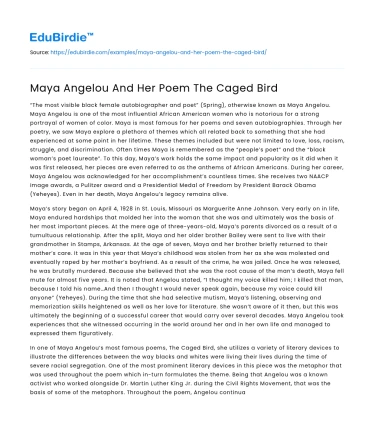“The most visible black female autobiographer and poet” (Spring), otherwise known as Maya Angelou. Maya Angelou is one of the most influential African American women who is notorious for a strong portrayal of women of color. Maya is most famous for her poems and seven autobiographies. Through her poetry, we saw Maya explore a plethora of themes which all related back to something that she had experienced at some point in her lifetime. These themes included but were not limited to love, loss, racism, struggle, and discrimination. Often times Maya is remembered as the “people’s poet” and the “black woman’s poet laureate”. To this day, Maya’s work holds the same impact and popularity as it did when it was first released, her pieces are even referred to as the anthems of African Americans. During her career, Maya Angelou was acknowledged for her accomplishment’s countless times. She receives two NAACP image awards, a Pulitzer award and a Presidential Medal of Freedom by President Barack Obama (Yeheyes). Even in her death, Maya Angelou’s legacy remains alive.
Maya’s story began on April 4, 1928 in St. Louis, Missouri as Marguerite Anne Johnson. Very early on in life, Maya endured hardships that molded her into the woman that she was and ultimately was the basis of her most important pieces. At the mere age of three-years-old, Maya’s parents divorced as a result of a tumultuous relationship. After the split, Maya and her older brother Bailey were sent to live with their grandmother in Stamps, Arkansas. At the age of seven, Maya and her brother briefly returned to their mother’s care. It was in this year that Maya’s childhood was stolen from her as she was molested and eventually raped by her mother’s boyfriend. As a result of the crime, he was jailed. Once he was released, he was brutally murdered. Because she believed that she was the root cause of the man’s death, Maya fell mute for almost five years. It is noted that Angelou stated, “I thought my voice killed him; I killed that man, because I told his name…And then I thought I would never speak again, because my voice could kill anyone” (Yeheyes). During the time that she had selective mutism, Maya’s listening, observing and memorization skills heightened as well as her love for literature. She wasn’t aware of it then, but this was ultimately the beginning of a successful career that would carry over several decades. Maya Angelou took experiences that she witnessed occurring in the world around her and in her own life and managed to expressed them figuratively.
Save your time!
We can take care of your essay
- Proper editing and formatting
- Free revision, title page, and bibliography
- Flexible prices and money-back guarantee
In one of Maya Angelou’s most famous poems, The Caged Bird, she utilizes a variety of literary devices to illustrate the differences between the way blacks and whites were living their lives during the time of severe racial segregation. One of the most prominent literary devices in this piece was the metaphor that was used throughout the poem which in-turn formulates the theme. Being that Angelou was a known activist who worked alongside Dr. Martin Luther King Jr. during the Civil Rights Movement, that was the basis of some of the metaphors. Throughout the poem, Angelou continually references a ‘caged bird’ and a ‘free bird’. Having prior knowledge on her civil rights background and further breaking down the poem, we find that the caged bird represents someone who is oppressed, such as the African Americans during this time period as opposed to someone who is ignorant and free in reference to the white man. The metaphor is better depicted when she says, “The free bird thinks of…the fat worms waiting on a dawn bright lawn” (Angelou). Maya also utilizes imagery in this poem. When she writes, “A free bird leaps on the back of the wind and floats downstream till the current ends and dips his wing in the orange sunrays” (Angelou). In the first stanza, Maya is painting the image of a liberated bird flying through the sky untroubled and free, accompanied by the sun gleaming on its wings. With the author making the decision to paint this image, it allows the reader to understand the bliss that comes with freedom and the pain that the imprisonment endured by the caged bird that it is “singing” to be free of (Angelou). In the poem, we also see Angelou begin to personify the bird by changing its pronouns from “its” to “his”. Her artistic decision to do so further elucidates that the bird is a symbol for the minorities who are oppressed and feel a sense of confinement within their communities. The song the bird sings is their continuous cry for freedom.
Angelou is able to take something as dark as racial injustice and turn it into a literary work of art. Living in the midst of unequal opportunity in comparison to her white counterparts, Maya Angelou managed to overcome the trials and tribulations that served as barriers to her development as an artist. From overcoming the isolation that she put herself through at such a young age… Angelou continues with her influence on current and past generations with the variations of work she has put out and how it can relate to anyone on a different level. Throughout her career she managed to teach women and young girl’s confidence how to be comfortable in your own skin.






 Stuck on your essay?
Stuck on your essay?

